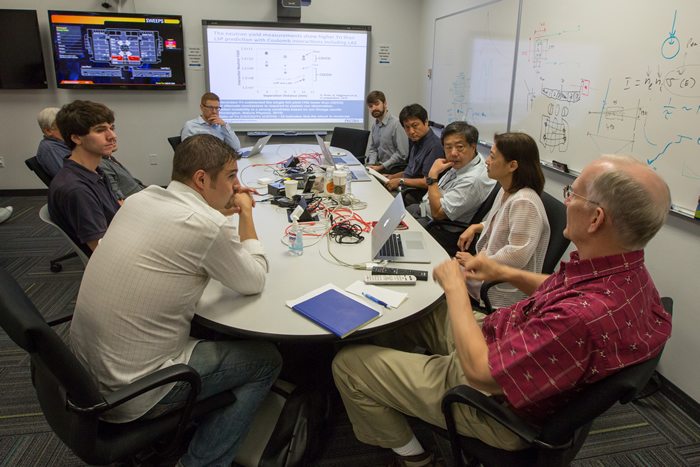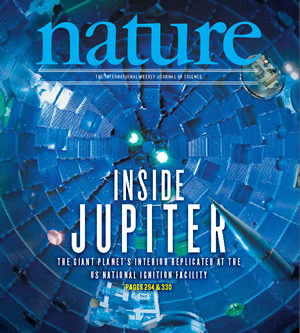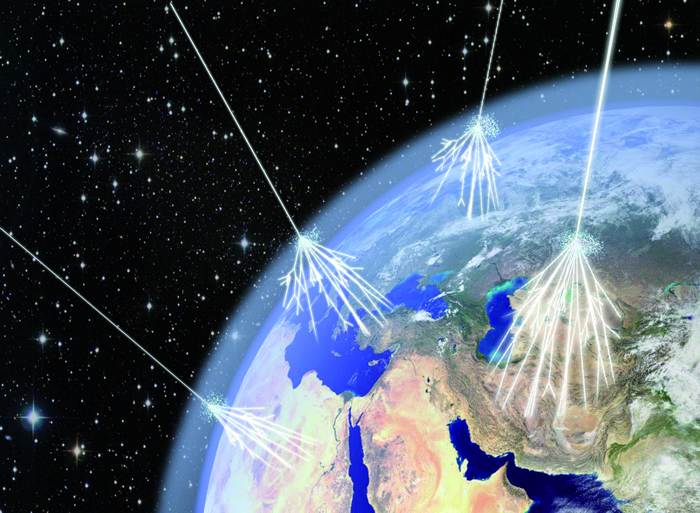Discovery Science

Understanding the Universe
Since the beginning of civilization, humans have marveled at the night sky and pondered the vast stretches of the universe. The 17th century invention of telescopes revealed the first details of the Moon and the planets in our solar system. Four hundred years later, space-based observatories such as NASA’s Hubble and Kepler regularly capture amazing vistas of billions of galaxies millions of light years away; while deep-space probes provide up-close data on the surface conditions on nearby planets and their moons.
“From nuclear physics to colliding galaxies, the reach of NIF Discovery Science seems bounded only by our own intellectual imaginations.”
—Discovery Science Program Leader Bruce Remington
And while we haven’t invented mighty starships to physically transport us to these distant worlds just yet, scientists now have a laboratory on Earth to better interpret astronomical observations, refine the latest models of how stars and planets are born and die, and strengthen their understanding of the workings of the cosmos. That laboratory is the National Ignition Facility.
NIF’s Discovery Science program offers opportunities for a broad range of users to perform experiments in high energy density science, including laboratory astrophysics (the branch of astronomy focused on understanding the physics of the universe), planetary science, high-pressure materials science, unique regimes of plasma physics, nuclear science, and particle acceleration. At the same time, the program provides a variety of benefits to NIF’s other missions and affords unique research opportunities to LLNL scientists as well as outside users.
The mechanisms that drive stars and other astrophysical phenomena such as supernovas, black holes, astrophysical shocks, and even planetary interiors are not well understood. By creating tiny parcels of plasma (a mixture of ions—atoms which have lost some or all of their electrons—and free electrons) under extreme conditions, scientists can better understand these physical processes and test theories previously based primarily on distant observations (see ”Giant lasers help re-create supernovas’ explosive, mysterious physics”).
 Discovery Science Program Leader Bruce Remington (right) meets with a team studying astrophysical collisionless shocks on NIF. Clockwise from Remington are Mario Manuel, General Atomics; Samuel Totorica, Stanford University graduate student; Dmitri Ryutov, Drew Higginson, and Hans Rinderknecht,; Youichi Sakawa, Osaka University; Chikang Li, MIT; and Hye-Sook Park, LLNL. Credit: Jason Laurea
Discovery Science Program Leader Bruce Remington (right) meets with a team studying astrophysical collisionless shocks on NIF. Clockwise from Remington are Mario Manuel, General Atomics; Samuel Totorica, Stanford University graduate student; Dmitri Ryutov, Drew Higginson, and Hans Rinderknecht,; Youichi Sakawa, Osaka University; Chikang Li, MIT; and Hye-Sook Park, LLNL. Credit: Jason Laurea The Discovery Science program provides scientists with powerful tools to explore matter at extraterrestrial conditions right here on Earth, while helping to make our nation’s nuclear stockpile safe and reliable (see “NIF and Stockpile Stewardship”). NIF’s 192 laser beams can simulate the extreme temperatures and crushing pressures found in stars and planets; this lets researchers test what happens to different materials and elements under those conditions.
International Partnerships
About 8 percent of NIF’s 400 experiments each year are set aside for these basic science campaigns. More than 100 Discovery Science experimental campaigns have been conducted or planned. They involve teams from two dozen of the most prestigious universities, national labs, and research organizations in the United States, Europe, and Asia, often working in partnership with each other. Each team also works closely with an LLNL scientist.
 Nature’s July 2014 cover story highlighted NIF Discovery Science experiments.
Nature’s July 2014 cover story highlighted NIF Discovery Science experiments. The roster includes Stanford, UC Berkeley, UC San Diego, Oxford, Princeton, MIT, Osaka University, the University of Rochester’s Laboratory for Laser Energetics, Los Alamos National Laboratory, Rutherford Appleton Laboratory and the Atomic Weapons Establishment in the UK, the French Alternative Energies and Atomic Energy Commission (CEA), the Israel Atomic Energy Commission, and General Atomics.
These experiments create an academic pipeline, allowing students to experience first-hand all that NIF and LLNL have to offer. They also provide NIF scientists opportunities for peer review, prestigious publications, and broader collaborations.
Researchers have compressed a diamond sample to a record 50 million megabars—the pressure of 50 million Earth atmospheres—to recreate conditions that exist inside Jupiter, Saturn, and other planets. They have revealed how fluid hydrogen transforms into a metallic substance, bringing new insight into the structure and formation of giant planets and solar systems.
Another campaign seeks to recreate conditions found inside stars. And researchers have created collisionless shocks to study astrophysical phenomena such as supernova remnants, gamma-ray bursts from active galactic nuclei, and cosmic magnetic fields.
 An illustration of “air showers” that result when ultra-high-energy cosmic rays strike the top of the Earth’s atmosphere and collide with air nuclei, producing other particles that lose most of their energy before reaching the ground. The origins of the highest-energy cosmic rays, which tend to be nuclei from heavier elements such as carbon and iron, are uncertain. Many scientists believe they are produced during supernova explosions, but recent studies indicate that they might be sent on their way by activity near the black holes at the center of the Milky Way and other galaxies. Credit: Asimmetrie/INFN, via CERN
An illustration of “air showers” that result when ultra-high-energy cosmic rays strike the top of the Earth’s atmosphere and collide with air nuclei, producing other particles that lose most of their energy before reaching the ground. The origins of the highest-energy cosmic rays, which tend to be nuclei from heavier elements such as carbon and iron, are uncertain. Many scientists believe they are produced during supernova explosions, but recent studies indicate that they might be sent on their way by activity near the black holes at the center of the Milky Way and other galaxies. Credit: Asimmetrie/INFN, via CERN Discovery Science experiments also create the need for new diagnostic instruments, like TARDIS, NIF’s target diffraction in-situ platform. Originally developed to investigate a new diamond-like crystal structure of carbon, the platform was later used to study the properties of uranium and plutonium for stockpile stewardship experiments.
More Information
“NIF Research Will Shed Light on Black Holes and Astrophysical Plasmas,” NIF & Photon Science News, November 2, 2022
“Gently Compressing Materials to Record Levels,” Science & Technology Review, September, 2019
“Next 10 Discovery Science Experiments Chosen,” NIF & Photon Science News, February 6, 2019
“Discovery Science Inspires Novel Diagnostics for NIF,” NIF & Photon Science News, December, 2018
“Discovery Science Strengthens NIF’s Mission,” NIF & Photon Science News, November, 2018
“The NIF User Office: Where the World Meets the Laser,” NIF & Photon Science News, July, 2018
“NIF Creates Matter and Antimatter from Light,” NIF & Photon Science News, June, 2018
“Laser Experiments Illuminate the Cosmos,” Science & Technology Review, December, 2016
“A Stellar Experimental Facility for Stockpile Sustainment and Fundamental Science,” Science & Technology Review, December, 2016
“NIF Users Bring Ideas and Energy to Discovery Science,” NIF & Photon Science News, October, 2016
“A Big Week for NIF Discovery Science,” NIF & Photon Science News, August, 2016
“Smashing Science,” Science & Technology Review, December, 2015
“NIF Efficiencies Boost Discovery Science Experiments,” NIF & Photon Science News, September, 2015
Next up: Lab Astrophysics



